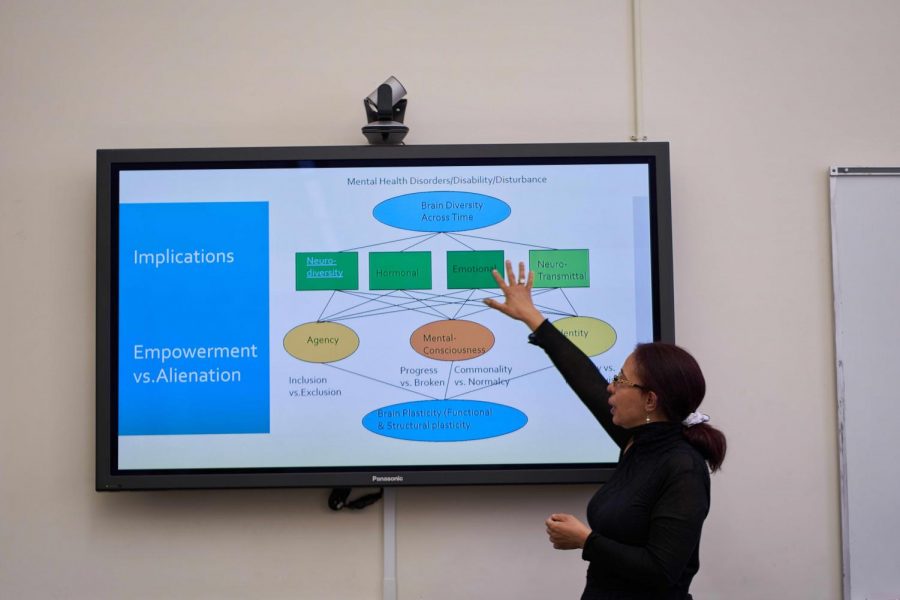Four faculty members from the Rhetoric, Communication and Theater department sat in the former Debate Room in St. John Hall to listen to Dr. Sanae Elmoudden discuss her research on mental health: “Growing Pains: Stigma and Mental Illness” Monday.
If a person meets someone with cancer, they ask about the healing process and praise their progress towards wellness, but they view people with mental illnesses as broken, Elmoudden said.
Elmoudden began studying mental illness after learning about her son’s depression and also began conducting an autoethnography, a type of qualitative research that ties personal experience into the wider culture. She drew from her personal experiences in the presentation of the research as well, sharing a vignetteshe wrote about her son called, “One Hour at a Time.”
“Not one day at a time because what happens right now might be different than what happens later and also how you solve the problem right now is completely different than how you’re going to solve the problem in the next minute, even though it’s the same problem,” Elmoudden said.
This hourly difference and case-by-case difference is important to understand about mental illness, Elmoudden stressed. She used depression as an example, saying each person is affected by depression differently.
Any person can be affected by mental illness, but Elmoudden said most people still talk about it quietly or not at all.
“They lower their voice as if this is something that needs to be shamed all the time,” Elmoudden said.
Mental illness can affect people of all backgrounds, religions, ethnicities, races and cultures and Elmoudden’s research explains why intersectionality should become a part of the conversation. The intersections of different oppressions like race, sexuality and religion also interact with the stigma mental illness brings, she said.
“For instance I am black, and I also happen to be a Muslim so I am at the intersection of black and Muslim,” Elmoudden said.
These interactions cause mental illness to be looked at differently across cultures. Mental illness in the Muslim community is more stigmatized than in other communities for example, she said.
Elmoudden emphasized using terms like “brain diversity” to remove the stigma from mental illness discussions. She said the term “neurodiversity” is already used in the autism field and believes all mental illnesses should be talked about this way.
She presented a chart showing a timeline of different categories of mental illness, neuro-diversity, hormonal, emotional and neuro-transmittal, and how they connect to identity, agency and mental-consciousness.
The stigma around mental illness is at the center of Elmoudden’s research. Her research attempts to provide a vocabulary normalizing mental illness. People should be aware of mental illness, not blind to it, she said.









John Hallowitz • Mar 22, 2019 at 2:45 pm
The core of the problem is not stigma but discrimination, hatred, and fear. Disorders of the mind are physical illness that arise from or cause dysfunctionality in the brain. This kind of hatred is still so ingrained in mainstream culture that many people participate, perpetuate, and promote prejudicial views thoughtlessly. The silence about disorders like bipolar, major depression, schizophrenia, and so forth can be directly traced to these embedded social prejudices.
A few of us, far too few of us, are open about and “own” having a brain disorder. Many people, especially at the onset of their own illness, have been so basted in negatives about disorders of the mind that they avoid or delay seeking help, getting a diagnosis, or receiving the most appropriate treatment. As Dr. Sanae Elmoudden correctly pointed out, intersectionality makes the importance of our taking the needs of the specific culture into account when engaging in outreach, treatment, and support. All this points to the need for health officials, politicians, advocates and caring individuals to promte and participate in broad public efforts to stop discrimination and combat engrained feelings of hatred and fear.
harold a maio • Mar 21, 2019 at 10:51 am
First, it is not at all unusual for someone to teach “there is a stigma” to mental illnesses. Nor is it at all unusual for someone to accept that lesson. We all too readily accept taught prejudices. without giving any thought to the consequences.
“The stigma around mental illness is at the center of Elmoudden’s research.” At the center of her research ought be people teaching or taught that prejudice.
Harold A Maio